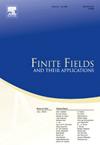Euclidean sets with only one distance modulo a prime ideal
IF 1.2
3区 数学
Q1 MATHEMATICS
引用次数: 0
Abstract
Let X be a finite set in the Euclidean space . If the squared distance between any two distinct points in X is an odd integer, then the cardinality of X is bounded above by , as shown by Rosenfeld (1997) or Smith (1995). They proved that there exists a -point set X in having only odd integral squared distances if and only if is congruent to 0 modulo 4. The distances can be interpreted as an element of the finite field . We generalize this result for a local ring as follows. Let K be an algebraic number field that can be embedded into . Fix an embedding of K into , and K is interpreted as a subfield of . Let be the ring of integers of K, and a prime ideal of . Let be the local ring obtained from the localization , which is interpreted as a subring of . If the squared distances of are in and each squared distance is congruent to some constant modulo , then , as shown by Nozaki (2023). In this paper, we prove that there exists a set attaining the upper bound if and only if is congruent to 0 modulo 4 when the finite field is of characteristic 2, and is congruent to 0 modulo p when is of characteristic p odd. We also provide examples attaining this upper bound.
只有一个距离模素理想的欧几里得集合
设X是欧几里德空间Rd中的一个有限集合。如果X中任意两个不同点之间的距离的平方是奇数,则X的基数以d+2为界,如Rosenfeld(1997)或Smith(1995)所示。他们证明了在Rd中存在一个(d+2)点集X只有奇数的平方积分距离当且仅当d+2等于0取4模。距离可以解释为有限场Z/2Z的一个元素。我们将这个结果推广到局部环(Ap,pAp)如下:设K是一个可嵌入R中的代数数域,将K嵌入R,则K被解释为R的一个子域。设a =OK是K的整数环,p是OK的素理想。设(Ap,pAp)是由定位(A∈p)−1A得到的局部环,它被解释为r的子环。如果X∧Rd的平方距离在Ap中,并且每个平方距离都等于某个常数k 0模pAp,则|X|≤d+2,如Nozaki(2023)所示。本文证明了存在一个集合X∧Rd,当且仅当当有限域Ap/pAp为特征2时,d+2与0模4全等,且当Ap/pAp为特征p奇时,d+2与0模p全等,达到上界|X|≤d+2。我们也提供了得到这个上界的例子。
本文章由计算机程序翻译,如有差异,请以英文原文为准。
求助全文
约1分钟内获得全文
求助全文
来源期刊
CiteScore
2.00
自引率
20.00%
发文量
133
审稿时长
6-12 weeks
期刊介绍:
Finite Fields and Their Applications is a peer-reviewed technical journal publishing papers in finite field theory as well as in applications of finite fields. As a result of applications in a wide variety of areas, finite fields are increasingly important in several areas of mathematics, including linear and abstract algebra, number theory and algebraic geometry, as well as in computer science, statistics, information theory, and engineering.
For cohesion, and because so many applications rely on various theoretical properties of finite fields, it is essential that there be a core of high-quality papers on theoretical aspects. In addition, since much of the vitality of the area comes from computational problems, the journal publishes papers on computational aspects of finite fields as well as on algorithms and complexity of finite field-related methods.
The journal also publishes papers in various applications including, but not limited to, algebraic coding theory, cryptology, combinatorial design theory, pseudorandom number generation, and linear recurring sequences. There are other areas of application to be included, but the important point is that finite fields play a nontrivial role in the theory, application, or algorithm.

 求助内容:
求助内容: 应助结果提醒方式:
应助结果提醒方式:


